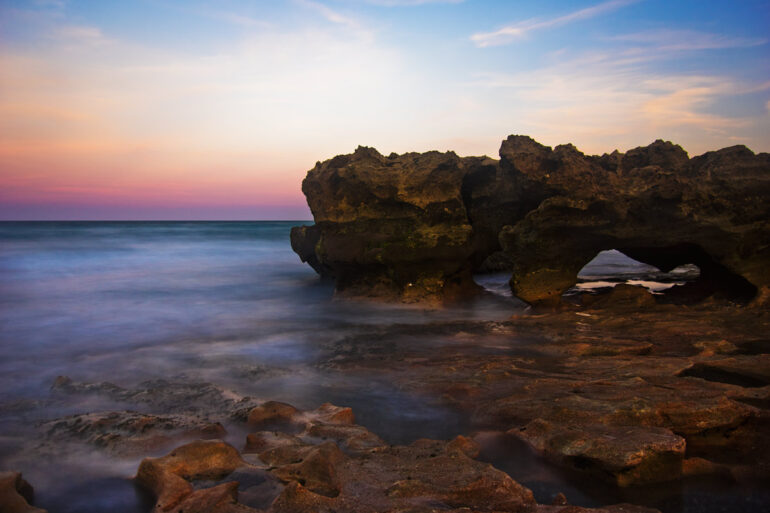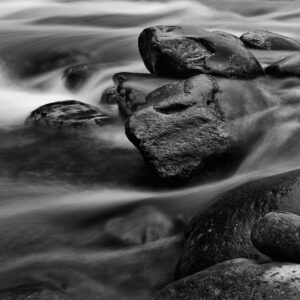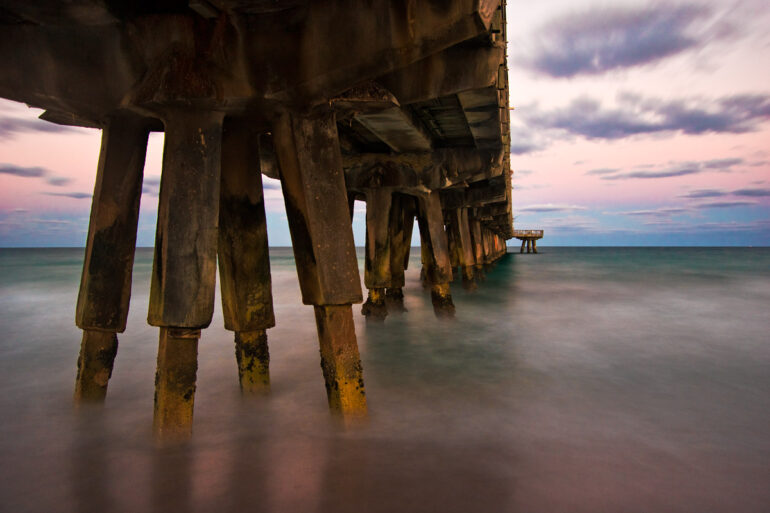We may earn a commission when you purchase through affiliate links. Learn more.
If you’ve found your way to this tutorial, you probably agree with me that long exposure photography is one of the most interesting and enjoyable types of photography. While traditional still photography focuses on capturing a single instant in a photo, long exposure photography allows us to record a longer amount of time in a single image. Aesthetically, long exposure photography can be beautiful — it smoothes and blurs moving objects like clouds, water, people and vehicles, making stationary subjects like rocks, buildings, and bridges stand out. When most photographers begin experimenting with long exposure photography, they begin at night — a time when it’s typically easy to leave the shutter open for several seconds at a time without needing to worry about overexposure.
Over the last decade, daytime long exposure photography has skyrocketed in popularity, and in this tutorial we’ll go over the techniques that you can use to create stunning daytime long exposure photos.
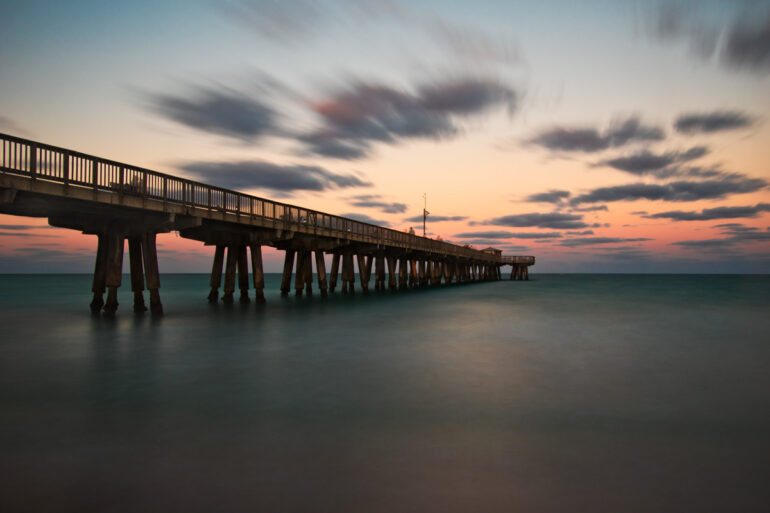
While short exposures where the shutter stays open for just a tiny fraction of a second are the norm for daytime photography, long exposures allow us to create images which present reality creatively in our own alternative way. Fast moving objects can become essentially invisible and even slow moving elements like a crowd of people can become a ghostly blur if the shutter is left open for long enough. Crashing waves become an ethereal fog, swirling around rocks, and clouds become smooth, painterly streaks across a dark sky. Done well, long exposure photography gives photographers so many options to expand their creativity and present the world in a new way.
If photography in general can be summarized as capturing a moment in time, long exposure photography is all about stretching that moment and capturing something more — something that a short exposure just can’t.
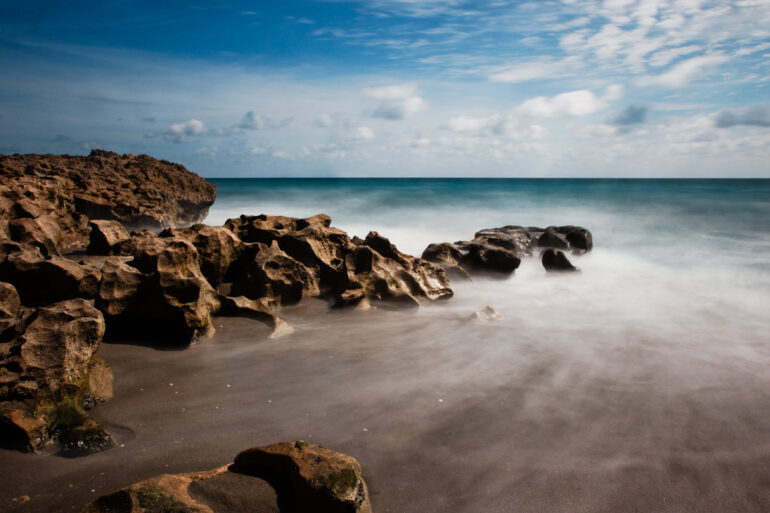
Exposure Basics for Daytime Long Exposure Photography
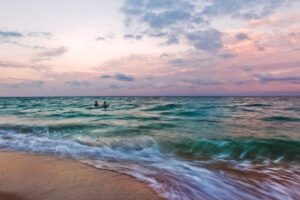 On a bright sunny day, it’s usually easy to use a fast shutter speed. With lots of ambient light in the middle of the day, we might be able to use the exposure settings of 1/400th, f/8, and ISO 100 to freeze the motion of waves rolling onto a rocky shoreline. But what if we wanted to smooth the motion of these waves to create an artistic image? Even using the smallest aperture setting which allows the least light into the lens (often f/22 for most lenses), we won’t be able to use a long enough shutter speed to smooth the water in an appealing way. Furthermore, there are some other side effects of such a small aperture, namely that more of the foreground and background of you image will be in focus, something you may not always want in every composition.
On a bright sunny day, it’s usually easy to use a fast shutter speed. With lots of ambient light in the middle of the day, we might be able to use the exposure settings of 1/400th, f/8, and ISO 100 to freeze the motion of waves rolling onto a rocky shoreline. But what if we wanted to smooth the motion of these waves to create an artistic image? Even using the smallest aperture setting which allows the least light into the lens (often f/22 for most lenses), we won’t be able to use a long enough shutter speed to smooth the water in an appealing way. Furthermore, there are some other side effects of such a small aperture, namely that more of the foreground and background of you image will be in focus, something you may not always want in every composition.
To use a longer exposure time and have more flexibility over what aperture settings you can use, we’ll need to somehow reduce the amount of light that reaches the camera’s sensor. Fortunately the solution is pretty simple. Imagine that you are sitting on the beach on an incredibly bright, sunny day. You fall asleep for a while in the warm sun and when you wake up, the sun is so blinding that you can barely open your eyes. You reach for your pair of dark sunglasses and instantly you can see again — their dark lenses reduce the amount of light that reaches your eyes. For daytime long exposure photography, the camera’s version of sunglasses comes in the form of a neutral density filter, essentially a piece of dark glass (or plastic) that blocks a specific amount of light from reaching the sensor, just like sunglasses block a certain amount of light from reaching our eyes. The darker this filter, the less light reaches the sensor.
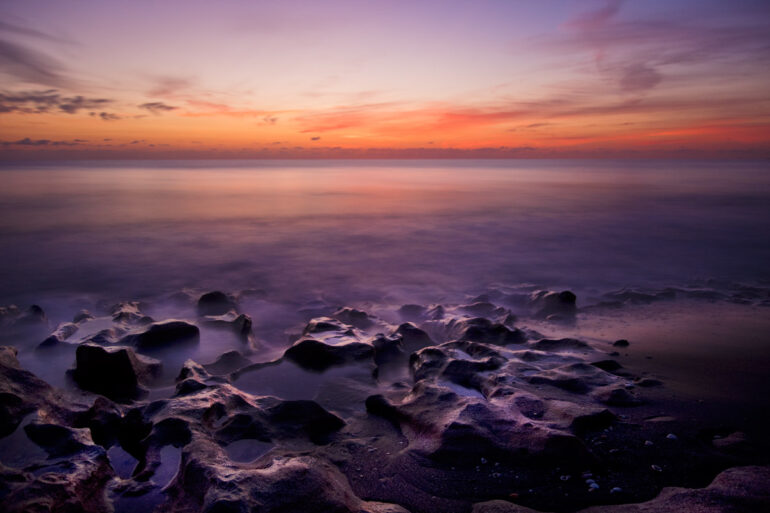
What You’ll Need for Daytime Long Exposure Photography
While nighttime long exposure photography doesn’t really require anything more than a camera that can shoot long exposures, a tripod, and a shutter release cable, daytime long exposure photography may require a few more items of gear.
A Sturdy Tripod
As with any kind of long exposure photography, a sturdy tripod is one of the most essential things you’ll need. Since the shutter will be left open for a prolonged amount of time, any shaking of the camera will become evident in your photos. Although we want the moving elements in a long exposure photo to be smoothed and blurred, we don’t want the stationary objects like rocks and buildings to be blurry. Long exposure photos that will include the sky in them are often best taken on windy days to get good cloud movement, so a tripod that doesn’t shake in the wind is critical.
Much like cameras and lenses, tripods vary widely in quality and price. For long exposure photography, avoid the cheap plastic tripods you can buy at the drugstore while on vacation. A good tripod should last for several years and you’re better off starting with a high quality aluminum or carbon fiber tripod. For reducing vibrations, a solid wooden tripod is great — but you probably don’t want to be carrying a heavy chunk of tree around on a long hike. For the budget shooters, tripods like the Manfrotto Befree Advanced, Benro Adventure 2, and SIRUI AM-225 are all highly rated tripods that can be purchased for less than $300.
A Camera with Manual Exposure Control
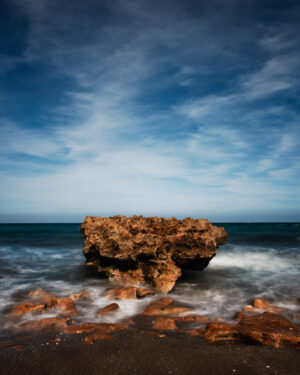 You’ll need a camera that you can control the exposure on manually. From the tiny and ultra-affordable mirrorless Canon R100 to the full frame Nikon D780 DSLR, any modern mirrorless or DSLR camera should fit the bill and even many compact cameras like the Canon G7 X Mark III can even be used on manual mode, but since we’ll be attaching light blocking filters to the camera lens for daytime long exposure photography, it will be much easier to use a camera and lens combination that has a filter thread for easy attachment.
You’ll need a camera that you can control the exposure on manually. From the tiny and ultra-affordable mirrorless Canon R100 to the full frame Nikon D780 DSLR, any modern mirrorless or DSLR camera should fit the bill and even many compact cameras like the Canon G7 X Mark III can even be used on manual mode, but since we’ll be attaching light blocking filters to the camera lens for daytime long exposure photography, it will be much easier to use a camera and lens combination that has a filter thread for easy attachment.
A Shutter Release Cable
Remote shutter control is essential for capturing long exposures without introducing any camera shake or vibrations, which can ruin a shot. Historically, the go-to tool for this was a shutter release cable, enabling photographers to shoot exposures longer than the preset maximum of 30 seconds offered by most DSLR and mirrorless cameras. To enable these longer exposures of custom length, you’ll need to set your camera to the Bulb mode. Without a cable, you’d have to hold the shutter button down for the entire exposure, potentially causing unwanted camera shake. A good shutter release cable should feature a locking mechanism to keep the shutter open without forcing you to physically hold down the button.
Most modern cameras also offer app-control via Wi-Fi or Bluetooth, making it easy to trigger exposures remotely using a smartphone app. This provides a very convenient way to start and stop exposures without needing to buy any additional gear.
For even more advanced control, an intervalometer can be used to set specific exposure times, number of exposures, and intervals between shots, which is especially useful for time-lapse photography. While not necessary for simple long exposures (as you can use a smartphone or a watch to keep track of exposure time), intervalometers still offer versatility and are worth considering if you frequently shoot time lapses or sequences of long exposures.
A Neutral Density (ND) Filter
While a neutral density filter is an optional (and often unnecessary) accessory for nighttime long exposure photography, it’s a real must-have for daytime shooting. An ND filter is basically just a dark piece of glass or plastic (often referred to as resin by the manufacturers) which reduces the amount of light that passes through the lens and reaches the camera’s sensor.
ND filters come in a variety of strengths, sizes, and even formats.
While low strength ND filters can be used to block just a stop or two of light, for daytime long exposure photography you will typically want to use fairly strong neutral density filters such as 9 and 10 stop filters, also referred to as ND400 and ND1000 filters. An ND400 filter like this one from Hoya reduces the light by 8 2/3 stops (the manufacturers round to 9 and call it a 9 stop ND filter) — this filter reduces the intensity of the light to just 1/400th of its original strength. An ND 1000 filter or 10 stop ND filter like this one from ICE reduces the light even more to just 1/1000th of its original strength, blocking out 99.9% of the light. A “stop” reduces the light by half, so a 3 stop ND filter allows in just 1/2 the light that a 2 stop ND filter does. A 4 stop ND filter allows in only half the light that a 3 stop ND would allow, and so on.
To give you an example of just how an ND filter helps, imagine that you’re trying to photograph a scene in reasonably bright conditions. Without any filter, your exposure time is 1/250. A 3 stop filter would allow you to increase your exposure time to 1/30….slower, but not really slow enough to smooth movement in an aesthetically pleasing way. A 6 stop ND filter will let you increase your exposure time to 1/4 second — enough to see some smoothing of moving objects like water or people running, but perhaps not as much as we’d like. With a 10 stop ND filter, we’re able to use a much longer 4 second exposure — long enough to get some nice smoothing effects for some elements like water, but probably not enough to smooth the movement of clouds. Add a second 10 stop ND filter on top of that 10 stop ND and now we’ve got a 20 stop reduction in light, meaning that our 4 second exposure time can increase to a whopping one hour+ long exposure. Lowering the ISO to reduce the sensitivity of your sensor and narrowing the aperture to allow less light to pass through your lens are two additional variables you can use to increase the exposure time as well, finding the balance of effects that works for the shot you want.
As you’ve probably noticed in your photography learning experience, it sometimes seems like everyone is just out to confuse you. ND filters are unfortunately one of those confusing things and it can be pretty easy to buy the wrong strength of filter if you’re not careful, so just re-read everything to be sure you’re getting what you really want. Some ND filter makers refer to the filter’s F-Stop reduction factor, calling a filter a 10 stop ND Filter. Others refer to the same strength of filter as an ND1000, referring to the filter factor (which is actually 1024, they just round down). Other manufacturers might call this same filter an ND 3.0, referring to the optical density. With so many numbers floating around, this can get confusing, since an ND 3.0 filter is not remotely the same thing as a 3 Stop ND filter.
Choosing a Filter Format
When selecting ND filters, you’re not only faced with picking the right strength but also choosing the format: screw-on ND filters, slide-in square filters, or the increasingly popular magnetic filters.
Screw-on filters are the most familiar type. They screw directly onto your lens just like a UV or circular polarizer filter, allowing you to use a lens hood to reduce lens flare in your images. However, one of the downsides is that they can be time-consuming to screw on and off, and there’s always the risk of accidentally dropping the filter while unscrewing it. If you use multiple lenses with different filter thread sizes, you’ll need to purchase step-up rings to adapt a filter to other lenses. Alternatively, you can use step-down rings, but be cautious as using a smaller filter on a larger lens can cause vignetting in your photos. If you’re planning to use step-up rings to use one filter across multiple lenses, it’s usually best to purchase a filter that fits the lens with the largest filter diameter.
Slide-in square/rectangular filters require a filter holder like the Cokin P or Cokin Z filter holder or Lee filter holder, which slides onto a filter adapter ring attached to your lens. These holders allow you to stack multiple filters (e.g., ND and graduated ND filters) for more creative control. While you won’t be able to use your lens’s normal hood while using these square filter holders, you can purchase hoods that are designed to fit these filter systems; a good idea especially for daytime long exposure photography to avoid lens flares.
Magnetic filters provide a newer and very convenient option. These filters attach magnetically to an adapter ring that screws onto the lens, allowing for quick attachment and removal without threading concerns. They are especially useful when you need to change filters frequently or stack different filters. Nearly all of us have experienced dropping a filter while trying to screw it onto a lens, so magnetic systems can be a great choice if you want to avoid fumbling with filter threads. Many brands now offer magnetic ND filters that are compatible with different lenses through the use of magnetic adapter rings, making them an ultra-versatile addition to any photographer’s kit.
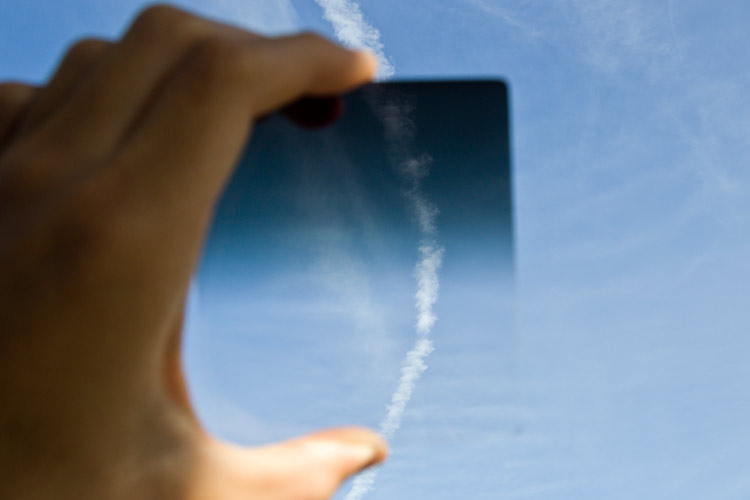
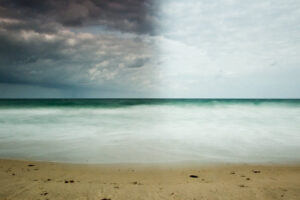
Graduated Neutral Density Filters are the tool of choice when you don’t need to reduce the brightness of every part of your scene. As their name suggests, these filters have a gradual distribution of darkness, with one half of the filter being darker and the other half being transparent, with a gradual area in between. These filters are especially useful for shooting long exposure images with the sky in them — an example might be at the beach during sunset: As the sun is setting, the water in the foreground is dark with the light source so close to the horizon. The sky is still very bright however, so to shoot a properly exposed long exposure photo, we want to block some of the light in the sky without blocking it from the water. A graduated neutral density filter or Grad ND does the trick, allowing us to selectively darken part of the scene. While these filters come in the circular variety, you’ll have the most flexibility with square graduated neutral density filters which will let you position the darker part of the filter where you want it, rather than directly in the middle of the lens.
In your search for an ND filter, you may come across variable neutral density filters like this one from K&F Concept. Essentially, a variable ND filter is composed of two stacked polarizing filters with one of them being able to rotate, reducing the light as the filters approach a perpendicular position. For lower strengths of light reduction, these variable neutral density filters can work well, but the closer you get to their maximum strength the more noticeable vignetting issues will become. While many variable filters claim a range up to 8 to 10 stops of light reduction, you’re usually not going to get usable results at these maximum settings with most lenses.
Affordable ND Filters: Are They Worth It?
The biggest downside to ND filters has historically been their price. For a small piece of dark glass, decent ND filters were VERY expensive to buy 10-15 years ago, but since then, many new competitors have come on the scene helping to drive costs down. If you want to buy a variety of ND filter strengths and some graduated neutral density filters from long-established brands like Lee, Hoya, and B+W, it can represent a pretty significant investment—potentially worthwhile if long exposure photography is a serious passion or professional pursuit, but also a bit overwhelming if you’re just starting out.
Luckily, there are now many options available at all price points, and the quality of budget ND filters has significantly improved over the years. Options from platforms like Amazon, eBay, and Aliexpress are more plentiful than ever, with some filters costing under ten dollars. But the question remains: do these bargain filters work? The short answer for many of them is yes—they do effectively reduce light.
However, there are some caveats that you should know before picking up the lowest cost filters you can find. Cheaper filters may have lower manufacturing standards, potentially resulting in image quality issues. While not every affordable brand delivers great results, there are more budget-friendly brands than ever before which offer quality products that deliver results that will work well for most photographers. Brands like K&F Concept, ICE, Gobe (now Urth), and Freewell provide ND filters that offer a good balance of quality and affordability. Ten years after I bought it, my 10-stop ND1000 filter from ICE is still going strong.
No products found.
A Circular Polarizer
Depending upon what you’re photographing, you may want to add a polarizing filter to your lens. This filter will help increase color saturation and contrast, reduce reflections on glass and water, and block 1 to 2 stops of light, allowing you to use a slightly longer exposure time. You can stack an ND filter and a polarizing filter to get the benefits of both, for instance when photographing a waterfall during the day. The Neutral Density filter will allow you to keep the shutter open for longer, smoothing the flow of the water in your photo, and the polarizer will cut the reflections on the water’s surface.
Shooting Daytime Long Exposure Photography
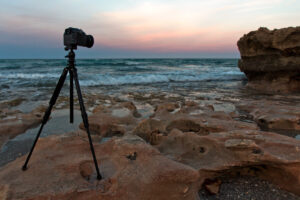
Set your tripod up in the most stable place possible. If I’m photographing on a rocky beach, whenever possible I will place the tripod legs on rocks, rather than on the sand. Even a small amount of water washing over the sand your tripod legs are resting on can shift the position of your tripod by a millimeter or two and ruin your shot. Unless I really need the extra height, I usually don’t extend my tripod’s center column when shooting long exposure photography — the further away from the stable legs that your camera gets, the more vulnerable it will be to slight vibrations. If I’m shooting along the coast, I usually keep my hands hovering within a few inches of the tripod if there is any risk of waves. I’ve had large waves come from seemingly out of nowhere, and being able to grab your camera and tripod and lift it up and out of harm’s way is important.
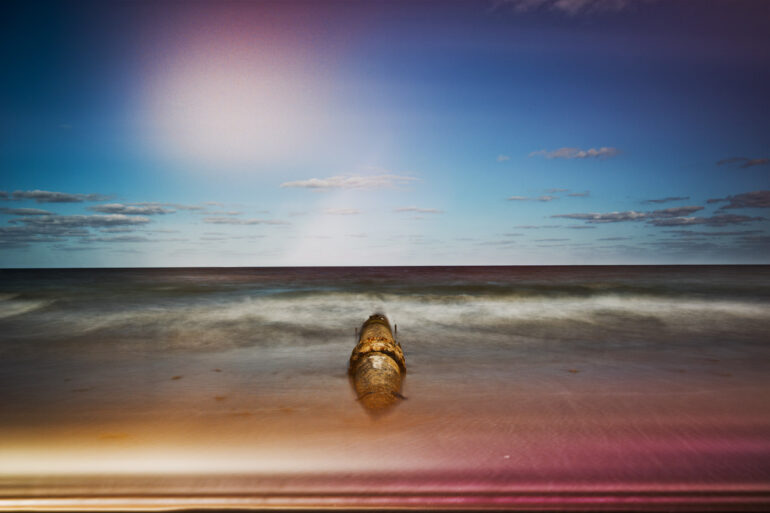
Preventing Light Leaks
While it’s not obvious when you’re shooting normal, short exposures, many cameras—including even the most expensive professional DSLRs—can have a noticeable light leak at the viewfinder. This occurs because DSLRs use an optical viewfinder that can allow a little bit of light to enter and affect the exposure when the mirror is locked up for long exposures. To counter this, some cameras provide a small door that you can slide shut to cover the viewfinder, while others include a viewfinder cover attached to the neck strap. If your camera doesn’t have a built-in method for dealing with light leaks, a simple piece of gaffer or electrical tape makes for an easy way to cover up the viewfinder.
It’s worth noting that this is primarily a DSLR-specific issue. Mirrorless cameras don’t have an optical viewfinder — they use an electronic viewfinder (EVF) or rely on the rear LCD screen for composing shots. Without an optical viewfinder, unless there’s a loose lens connection, there generally won’t be a way for light to enter a mirrorless camera body during long exposures.
Shooting in RAW
When you take a photo that’s recorded as a RAW file, the camera’s sensor data is preserved in the file without the camera’s processing algorithms applied to it. When you take a JPEG photo, the camera applies it’s processing algorithms and discards the data it didn’t use. Most modern digital cameras do a pretty good job of processing these JPEG files and not every situation calls for RAW, but most professionals shoot RAW for the photos that matter because it gives you a far greater ability to customize the way each image is processed.
Because a RAW file preserves all of the light information and a higher dynamic range from the sensor in an uncompressed file, you are able to recover more details from dark shadows and bright highlights than you would be able to with only a JPEG file. With a long exposure photograph, being able to process the image yourself is very important — long exposures can introduce unwanted color casts to a photo from light sources that might not be visible to the naked eye and from ND filters that can change the colors in a long exposure. Shooting and processing RAW will allow you to modify the color temperature of your image without losing any quality in the image.
Long exposures, even those taken during the day, can also introduce digital noise into your images which is easy to minimize during RAW processing. While shooting in RAW is the best choice for serious photographers, the files created tend to be quite a bit larger than JPEG images, but with the low cost of both memory cards and digital storage, this is less of an issue than ever before.
Long Exposure Noise Reduction
Most DSLR and mirrorless cameras have an optional setting that allows you to reduce digital noise when shooting long exposure photography. This feature, known as long exposure noise reduction (LENR), works by taking a second “dark frame” after your first exposure. The dark frame is essentially a shot taken with the shutter closed, capturing only the “hot pixel” noise and sensor defects. The camera then subtracts this noise from the original exposure to produce a cleaner final image.
Because long exposures can cause your camera to heat up, and this heat increases the digital noise recorded by your sensor, using this noise reduction option can be very helpful. However, the downside to it is that it essentially doubles your exposure time. For example, if you shoot a 2 minute long exposure, the second dark exposure will also take a further two minutes, meaning you won’t be able to shoot another shot for 4 minutes. No big deal if you’re not in a rush, but if you’re photographing at sunrise or sunset when lighting conditions can change rapidly and you’re trying to capture multiple images in rapid succession, you might be better off not using the long exposure noise reduction option.
Composing your Shot
If you’re using a very dark ND filter like an 8, 9, or 10-stop filter, composing your photo through the viewfinder can be quite challenging because you’ll barely see anything. The easiest solution is to compose your shot and set the focus before attaching the ND filter to your lens. This approach, while effective, can be time-consuming, especially if you’re using a circular screw-on ND filter and need to carefully attach it to the filter threads on your lens.
If your camera has a live view feature — common in both DSLRs and mirrorless cameras — you can use a quicker workaround to bypass this issue. By enabling live view and using exposure simulation preview, you can digitally zoom in on a specific area of your scene to manually set the focus. Many advanced compact cameras also offer similar features, making this technique applicable across various camera types. However, regardless of your camera setup, it’s crucial to set your lens to manual focus once you’ve composed your shot. Nothing is more bothersome than going through the trouble of carefully focusing, only to press the shutter and realize it’s still set to autofocus, forcing you to refocus your shot.
For mirrorless cameras, which rely on electronic viewfinders, the live view and focus magnification features can be even more advantageous, as they provide real-time exposure adjustments and a more accurate depiction of the final image. Advanced compacts, such as the Sony RX100 VII, offer similar focus aids and exposure simulation, ensuring more precise compositions even with dark filters.
Picking a Subject & Time of Day
Daytime long exposure photography techniques can be used to photograph just about anything, but certain subjects are especially well-suited. Including a moving element like water, clouds, or a crowd of people walking will make for a compelling shot. If you live near the ocean or a lake, find the nearest pier — these make for beautiful subjects, especially at sunrise and sunset. Quickly flowing rivers and streams are excellent subjects too — try to find an interesting subject like rocks in the water to build your composition around. If you’ve got some very strong ND filters, give daytime architecture photography a try. You’ll find that you’ll usually get the best results on a windy day with at least some clouds in the sky to add some smooth motion behind the buildings.
With a strong enough neutral density filter, you can shoot long exposures at any time of day. Personally, I usually prefer the early morning around sunrise and the evening around sunset for much of my daytime long exposure shooting. The late afternoon and middle of the day can cause harsh shadows if you’re shooting landscapes and seascapes on a bright, sunny day. Take some notes when you head out shooting about the lighting conditions, and you’ll soon develop your own personal preferences.
Proper Exposure
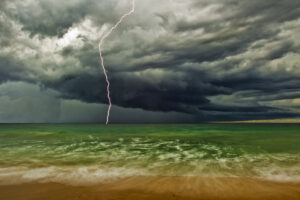 Experiment with a variety of exposure times — the longest possible time is not always going to make for the best shot; sometimes being able to see a bit of definition in a wave is a good thing. As with any type of photography, you should typically use the lowest ISO setting available to you. On most cameras the base ISO will be 100. As for the aperture setting, it may be preferable to use two ND filters in conjunction to achieve a longer exposure time, rather than simply using a smaller aperture since a smaller aperture has the side-effect of increasing the depth of field as well.
Experiment with a variety of exposure times — the longest possible time is not always going to make for the best shot; sometimes being able to see a bit of definition in a wave is a good thing. As with any type of photography, you should typically use the lowest ISO setting available to you. On most cameras the base ISO will be 100. As for the aperture setting, it may be preferable to use two ND filters in conjunction to achieve a longer exposure time, rather than simply using a smaller aperture since a smaller aperture has the side-effect of increasing the depth of field as well.
For long exposure times of more than 30 seconds in bright sunlight, you will likely need to use more than just one strong ND filter. For capturing the movement of clouds across the sky in a scene, exposure times of several minutes may be needed to obtain desirable results. Stacking two filters like a Hoya ND1000 and a Hoya ND400 will give you a reduction of 18 stops, enough to achieve an exposure of several minutes even in bright lighting conditions.
Learn More!
If you want to keep learning more about long exposure photography, be sure to check out these tutorials as well:
Long Exposure Photography Tips
Long Exposure Photography Examples and Settings

